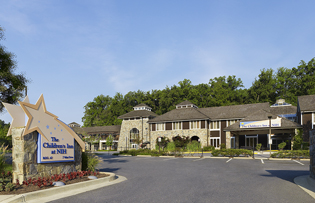Hope, Science, and Miracles
The NIH Children’s Inn Celebrates 25 Years

PHOTO BY HOCHLANDER DAVIS PHOTOGRAPY
“Those of us who come here, our heart in our hand[s], [hope] for a miracle.”
So said just one of the many grateful patients who come to be treated at the NIH Clinical Center (Building 10). The message rings true especially for families with children who have life-threatening illnesses and come to NIH hoping for a miracle. On June 18, the NIH Children’s Inn, which houses children and families, celebrated its 25th anniversary with a symposium titled, “At the Intersection of Hope and Science: 25 Years of Advancing Medical Discoveries.”
Since 1990, “nearly 12,000 children with serious, life-threatening illnesses have stayed at the Inn,” NIH Director Francis Collins told the physicians, patients, and families who had gathered in Masur Auditorium (Building 10) for the symposium. They came to NIH in search of help when conventional medical treatments had failed for their life-threatening and devastating diseases such as heart, lung, blood, bone, and growth disorders; mental illnesses; rare genetic conditions; many forms of cancer; and undiagnosed diseases. In most cases, the NIH was the last and best hope for a treatment or a cure. These children, said Collins, “have contributed to groundbreaking medical research” that has led to successful treatments.
The idea for the inn began to take shape in the early 1980s when Philip Pizzo, then chief of pediatrics at the National Cancer Institute, had a vision to create a homelike place on the NIH campus where families could stay while their children were being cared for at the Clinical Center. At the time, children’s families were supposed to find local accommodations, but that didn’t always work out.
“Families often wouldn’t tell you about it, but they were sleeping in the waiting rooms or even in their cars,” recalled Clinical Center Director John Gallin. “Many were eating primarily from vending machines that were in the hospital.”
The establishment of the inn, however, mitigated these problems. “The NIH Clinical Center cares for a child’s medical needs,” said Gallin. “The inn tends to a child’s heart, soul, spirit, and family.”
The NIH donated two acres of land on which to build the inn; Merck and Company, Inc., donated the funds for the project. In June 1990, the NIH Children’s Inn opened its doors to its first patients and their families. In the beginning the inn could host up to 36 families. In 2004, the inn was expanded to accommodate up to 59 families. In 2010, Woodmont House, which can host five families, opened just off-campus as a transitional home for families with children who were long-term patients but no longer in the acute phase of their illnesses. The families who have stayed at the inn or Woodmont House came from all 50 states as well as 86 countries.

PHOTO BY ERNIE BRANSON
The NIH Children’s Inn, celebrated its 25th anniversary recently with a symposium that attracted patients, clinicians, staff, and other supporters. The inn is a home-away-from home for families with children being treated at the Clinical Center.
“When the inn expanded, I was thrilled because that meant that more pediatric studies could take place,” said Benjamin Banks, one of the former patients who spoke at the symposium. “More doors would be opened, and more answers would be found.”
When the inn and Woodmont House are at capacity, the inn staff and NIH medical teams work with the families to find alternate accommodations. Even if the families are staying off-campus, they still have full access to all of the inn’s programs and services.
The inn “empowers the work done at the Clinical Center not only by providing the families a free place to stay, but [also] by reducing their stress and making their entire experience a little more bearable,” said Jennie Lucca, chief executive officer at the Children’s Inn. “NIH is their hope.”
“What I loved about the Children’s Inn was the camaraderie with the other children,” said Banks. “It didn’t matter if you were seven months old, seven years old, or like me, 17 years old. We were all friends.”
Collins, Gallin, and Lucca hope that the NIH Clinical Center and the Children’s Inn will continue to provide the very best services and programs to the courageous children and families who come to NIH in search of miracles.
Incidentally, another homelike residence at NIH is the Edmond J. Safra Family Lodge, which opened in 2005 and is for families of adult Clinical Center patients.
This page was last updated on Monday, April 25, 2022
